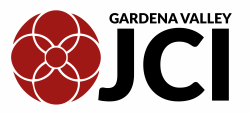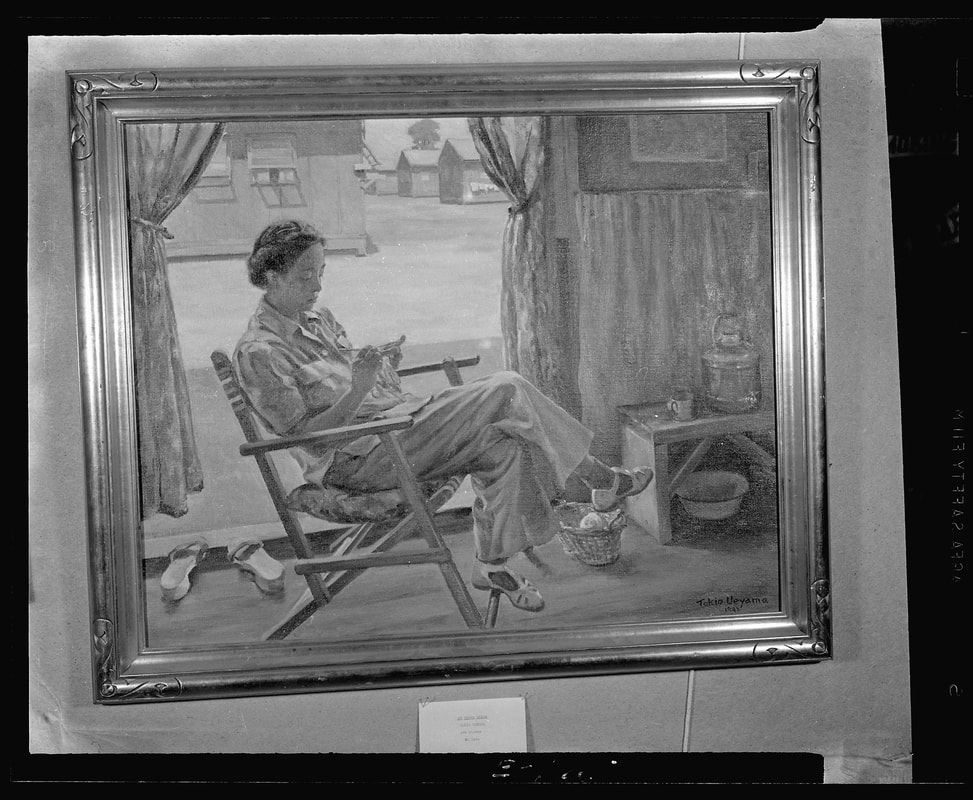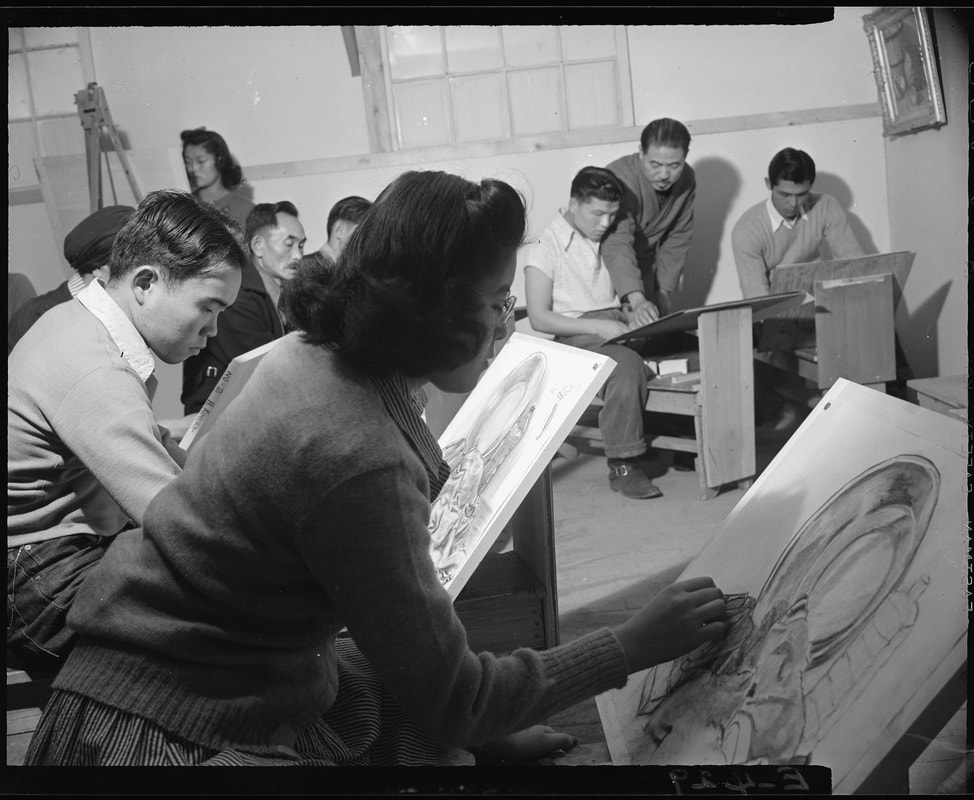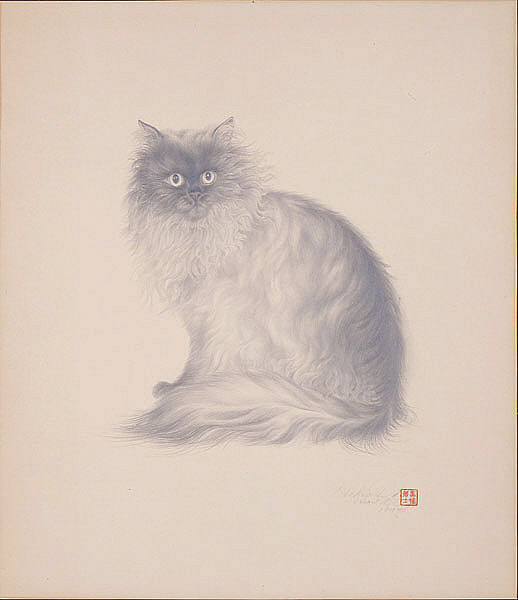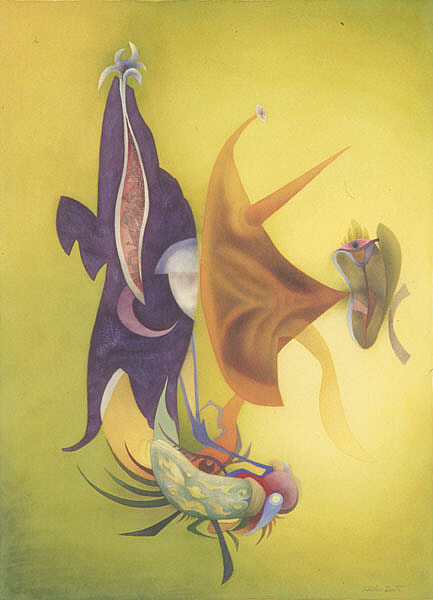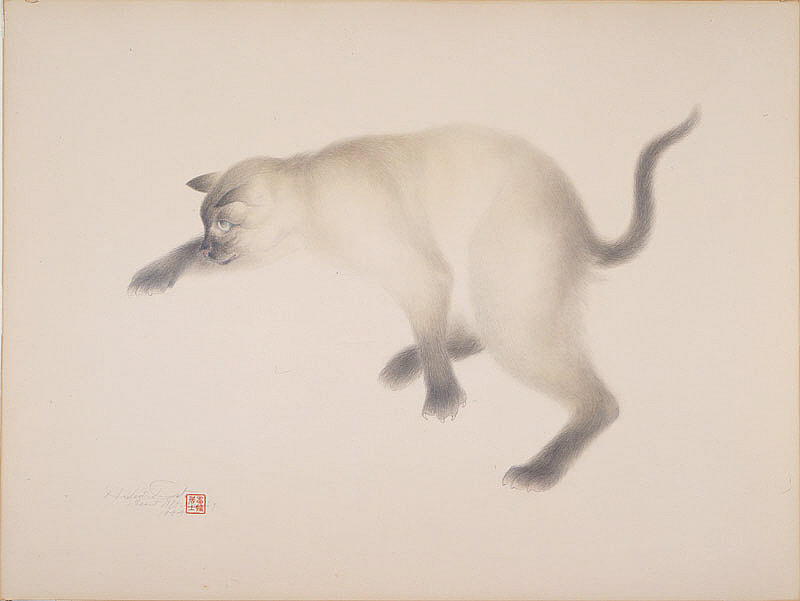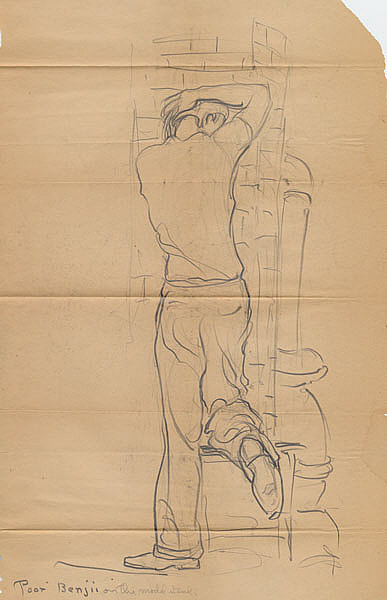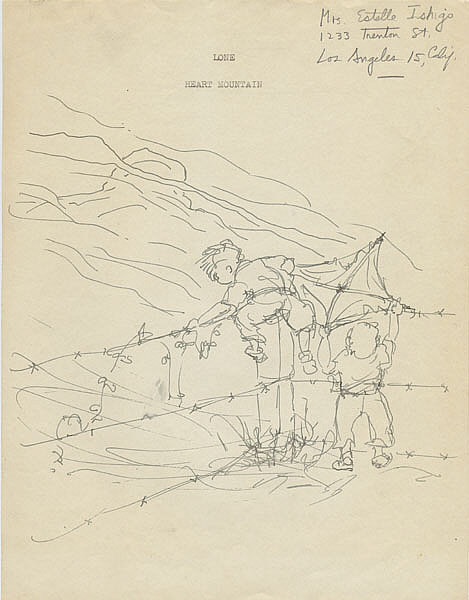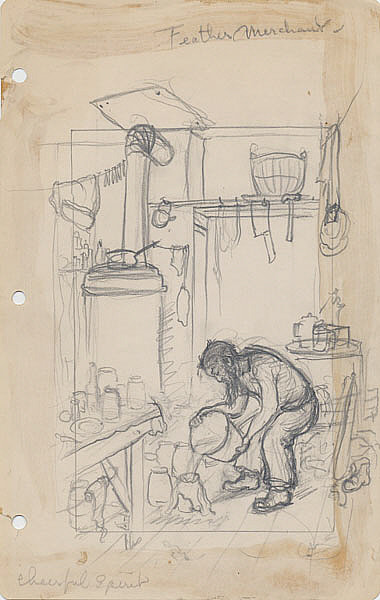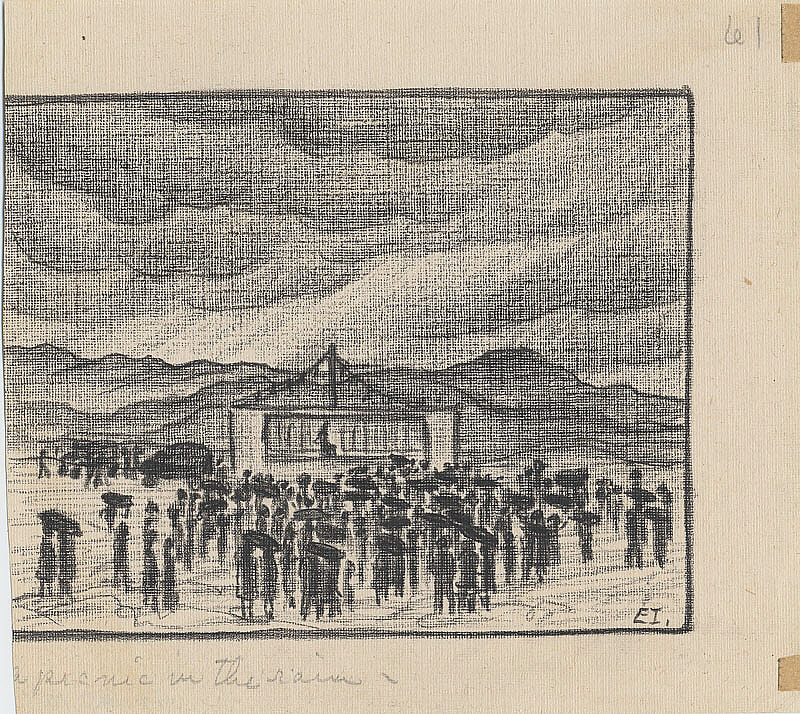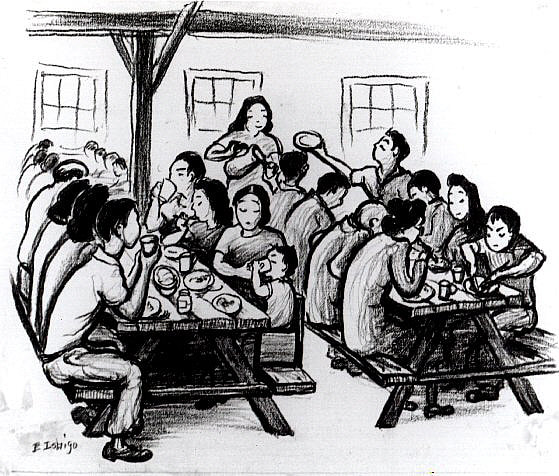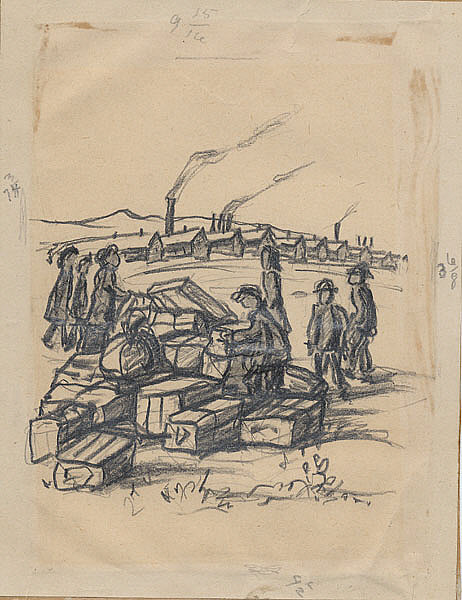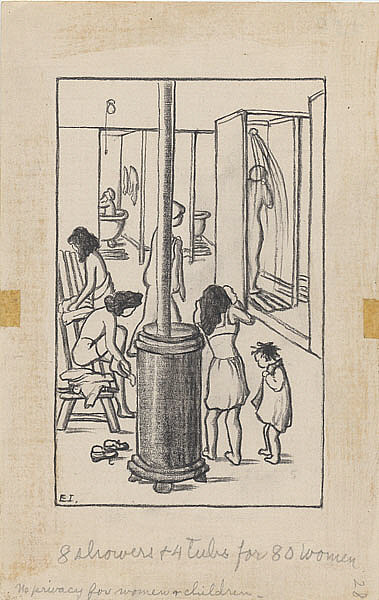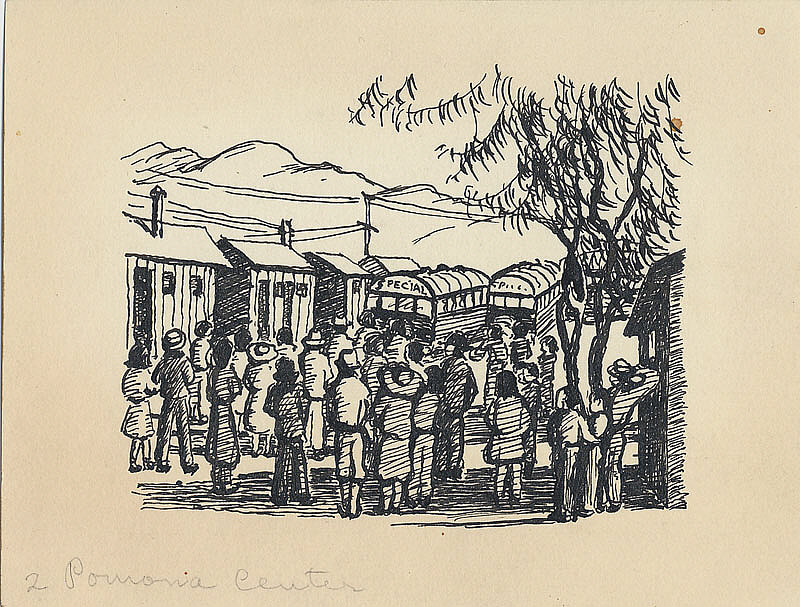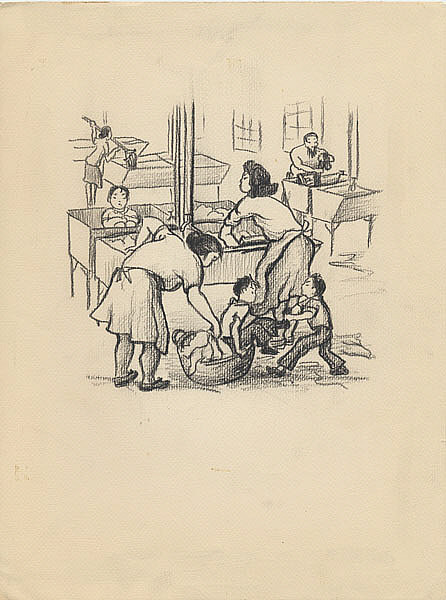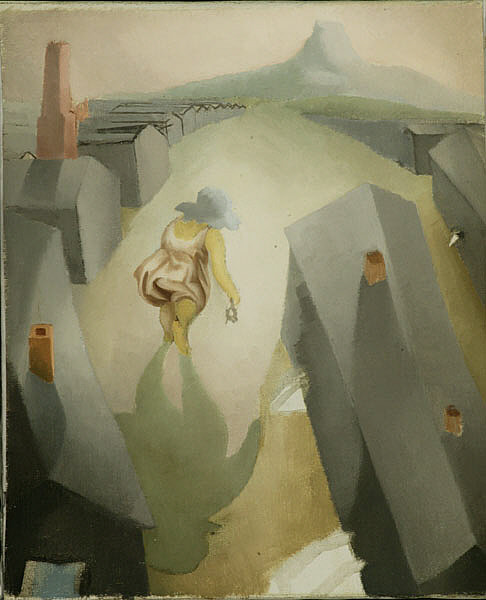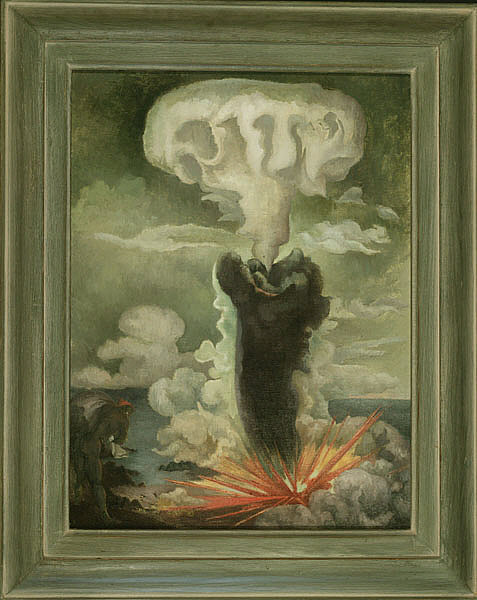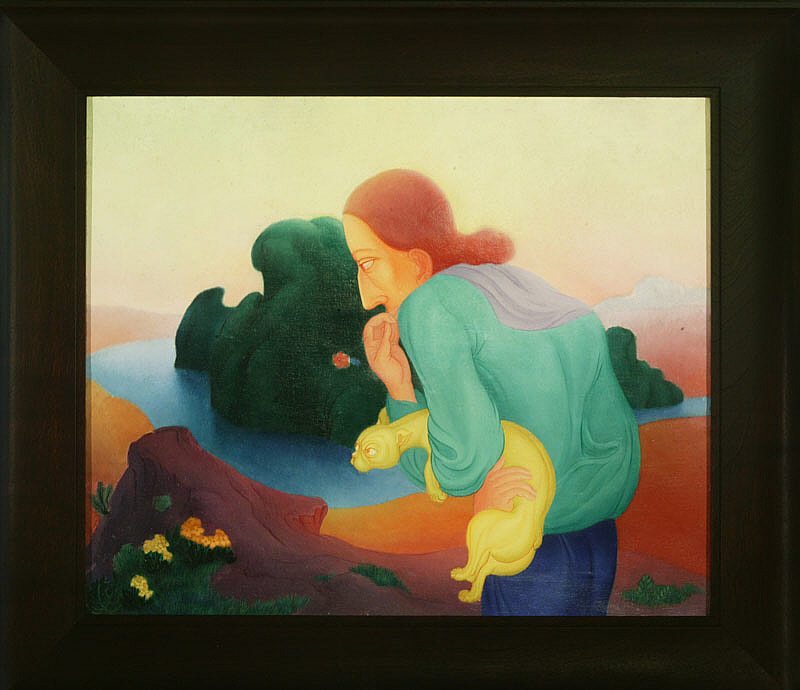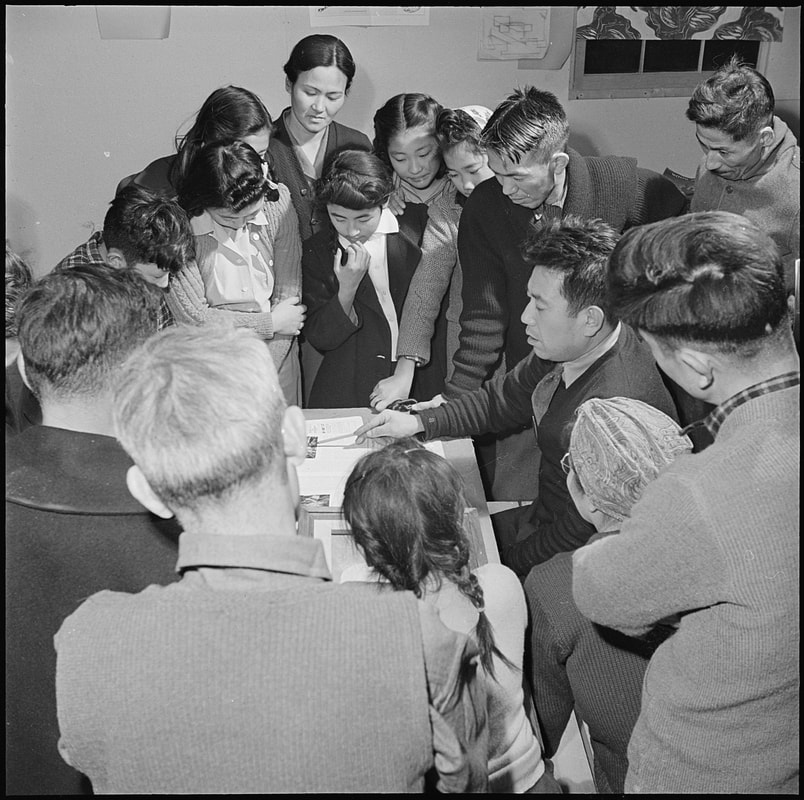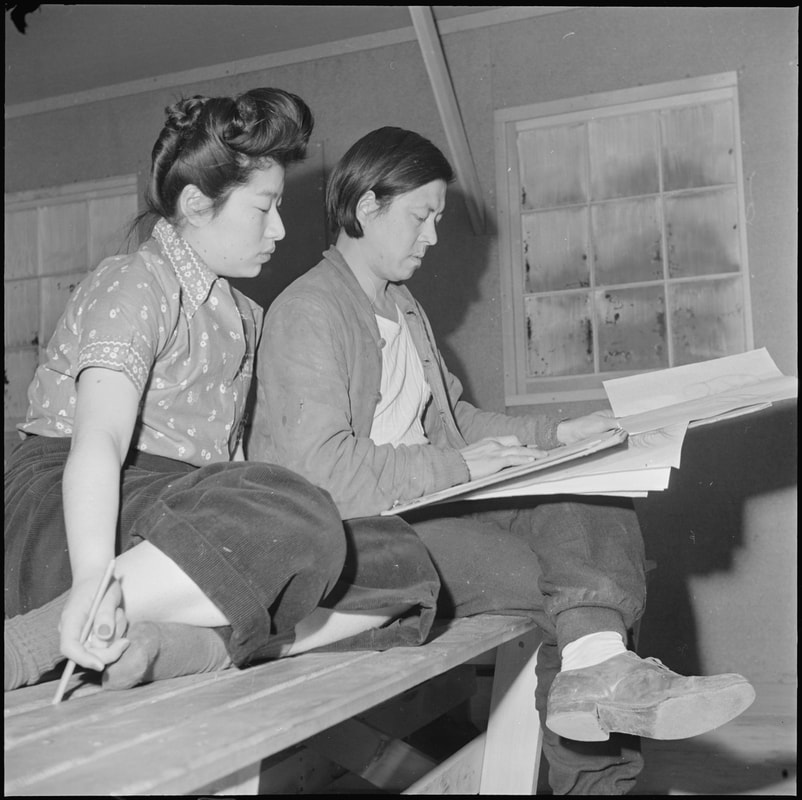FINE ART - AMACHE ART CLASSES
TOKIO UEYAMA
Born: September 22, 1889
Died: July 12, 1954
Birth Location: Wakayama, Japan
Tokio Ueyama (1889-1954) was an oil painter who created realistic landscapes, still-lifes and portraits, and exhibited extensively in prewar San Francisco and Los Angeles, before he was incarcerated at Amache, Colorado. He was born on September 22, 1889, in Wakayama, Japan, and immigrated to the United States at age nineteen to study at the San Francisco Institute of Art. In 1910, he moved to Los Angeles and enrolled at the University of Southern California, graduating with a degree in fine arts in 1914. He continued his studies at the Pennsylvania Academy of the Fine Arts in Philadelphia before he was chosen for a Cresson travel scholarship, which enabled him to travel and study painting in France, Germany, Italy and Spain in 1920.
Courtesy of Patricia Wakida, Densho
Granada concentration camp, Amache, Colorado. This portrait painting was made at the Santa Anita Assembly Center by Tokio Ueyama, head of the art studio at the Granada Center and displayed at the Arts and Crafts Exhibit, sponsored by the Education Division and the "Pioneer," the center newspaper, at Terry Hall.
3/6/1943
National Archives Identifier: 539296 Local Identifier: 210-G-E765
3/6/1943
National Archives Identifier: 539296 Local Identifier: 210-G-E765
|
Granada concentration camp, Amache, Colorado. An adult art class under the direction of Tokio Ueyama, working in pencil sketch charcoals and oils. Adult art classes are extremely popular at the Amache Center.
12/10/1942 Parker, Tom, Photographer National Archives Identifier: 539004 Local Identifier: 210-G-E424 |
Granada concentration camp, Amache, Colorado. In an adult still life art class, Tokio Ueyama gives a few pointers to one of the students.
12/10/1942 Parker, Tom, Photographer National Archives Identifier: 539008 Local Identifier: 210-G-E429; |
THE ART STUDENT'S LEAGUE OF HEART MOUNTAIN
Hideo Date
Born: January 5 1907
Died: January 6 2005
Birth Location: Osaka, Japan
Hideo Date (1907-2005) was a New York-based artist who taught art classes at Heart Mountain. Born in Osaka, Japan, on January 5, 1907, he was the third son of Imasuke and Yusa Date. Shortly after Date's birth, his father left to find work in California and opened a hardware store in Fresno, California. Date immigrated to California in 1923, joining his mother and brothers who were already working to support the family. He labored in the Central Valley orchards until his father's hardware store closed, which precipitated moving the family to Los Angeles.
Courtesy of Patricia Wakida, Densho
Born: January 5 1907
Died: January 6 2005
Birth Location: Osaka, Japan
Hideo Date (1907-2005) was a New York-based artist who taught art classes at Heart Mountain. Born in Osaka, Japan, on January 5, 1907, he was the third son of Imasuke and Yusa Date. Shortly after Date's birth, his father left to find work in California and opened a hardware store in Fresno, California. Date immigrated to California in 1923, joining his mother and brothers who were already working to support the family. He labored in the Central Valley orchards until his father's hardware store closed, which precipitated moving the family to Los Angeles.
Courtesy of Patricia Wakida, Densho
Untitled
Maker Date, Hideo
Date unknown
Medium paper, pencil
Dimensions H: 21in, W: 18 in
Date, Hideo. Untitled. “Hideo Date Collection”. Featured Collections. Museum Collection. Research & Collections. Japanese American National Museum. 27 Dec 2021, 13:21 PST
<https://janm.emuseum.com/objects/25588/untitled>
Maker Date, Hideo
Date unknown
Medium paper, pencil
Dimensions H: 21in, W: 18 in
Date, Hideo. Untitled. “Hideo Date Collection”. Featured Collections. Museum Collection. Research & Collections. Japanese American National Museum. 27 Dec 2021, 13:21 PST
<https://janm.emuseum.com/objects/25588/untitled>
Untitled
Maker Date, Hideo
Date 1945-1955
Medium watercolor, paper
Dimensions H: 29.378 in, W: 21.75 in
Date, Hideo. Untitled. “Hideo Date Collection”. Featured Collections. Museum Collection. Research & Collections. Japanese American National Museum. 2 Nov 2021, 22:50 PST
<https://janm.emuseum.com/objects/27407/untitled?ctx=aaf0fbbb0a02cc96c4d9f6abf2f7adf2aa7ae644&idx=91>
Maker Date, Hideo
Date 1945-1955
Medium watercolor, paper
Dimensions H: 29.378 in, W: 21.75 in
Date, Hideo. Untitled. “Hideo Date Collection”. Featured Collections. Museum Collection. Research & Collections. Japanese American National Museum. 2 Nov 2021, 22:50 PST
<https://janm.emuseum.com/objects/27407/untitled?ctx=aaf0fbbb0a02cc96c4d9f6abf2f7adf2aa7ae644&idx=91>
Untitled
Maker Date, Hideo
Date 1944
Medium colored pencil, pencil, paper
Dimensions H: 18 in, W: 24 in
Date, Hideo. Untitled. “Hideo Date Collection”. Featured Collections. Museum Collection. Research & Collections. Japanese American National Museum. 2 Nov 2021, 22:45 PST
<https://janm.emuseum.com/objects/25591/untitled?ctx=aaf0fbbb0a02cc96c4d9f6abf2f7adf2aa7ae644&idx=90>
Maker Date, Hideo
Date 1944
Medium colored pencil, pencil, paper
Dimensions H: 18 in, W: 24 in
Date, Hideo. Untitled. “Hideo Date Collection”. Featured Collections. Museum Collection. Research & Collections. Japanese American National Museum. 2 Nov 2021, 22:45 PST
<https://janm.emuseum.com/objects/25591/untitled?ctx=aaf0fbbb0a02cc96c4d9f6abf2f7adf2aa7ae644&idx=90>
Estelle Peck Ishigo
Born: July 15 1899
Died: February 25 1990
Birth Location: Oakland, California
Estelle Ishigo (July 15, 1899 – February 25, 1990), née Peck, was an American artist known for her watercolors, pencil and charcoal drawings, and sketches. During World War II she and her husband were incarcerated at the Heart Mountain Relocation Center in Wyoming. She subsequently wrote about her experiences in Lone Heart Mountain and was the subject of the Oscar winning documentary Days of Waiting: The Life & Art of Estelle Ishigo.
Ishigo stands out as being one of the few individuals who were not ethnically Japanese, incarcerated under Executive Order 9066.
Courtesy of Patricia Wakida, Densho
Born: July 15 1899
Died: February 25 1990
Birth Location: Oakland, California
Estelle Ishigo (July 15, 1899 – February 25, 1990), née Peck, was an American artist known for her watercolors, pencil and charcoal drawings, and sketches. During World War II she and her husband were incarcerated at the Heart Mountain Relocation Center in Wyoming. She subsequently wrote about her experiences in Lone Heart Mountain and was the subject of the Oscar winning documentary Days of Waiting: The Life & Art of Estelle Ishigo.
Ishigo stands out as being one of the few individuals who were not ethnically Japanese, incarcerated under Executive Order 9066.
Courtesy of Patricia Wakida, Densho
Poor Benjii on the Model Stand
Maker Ishigo, Estelle
Date 1942-1945
Medium pencil, paper
Dimensions H: 16.75 in, W: 11 in
Sketch of male, most likely fellow artist Benji Okubo.
Estelle Ishigo. “Poor Benjii on the Model Stand”. 1942-1945. “Estelle Ishigo Collection”. Featured Collections. Museum Collection. Research & Collections. Japanese American National Museum. 14 Jan 2022, 22:54. <https://janm.emuseum.com/objects/33003/poor-benjii-on-the-model-stand?ctx=31bab6f94a4b7fe85b6913e59c7df42b76c70484&idx=50>
Maker Ishigo, Estelle
Date 1942-1945
Medium pencil, paper
Dimensions H: 16.75 in, W: 11 in
Sketch of male, most likely fellow artist Benji Okubo.
Estelle Ishigo. “Poor Benjii on the Model Stand”. 1942-1945. “Estelle Ishigo Collection”. Featured Collections. Museum Collection. Research & Collections. Japanese American National Museum. 14 Jan 2022, 22:54. <https://janm.emuseum.com/objects/33003/poor-benjii-on-the-model-stand?ctx=31bab6f94a4b7fe85b6913e59c7df42b76c70484&idx=50>
Lone Heart Mountain
Maker Ishigo, Estelle
Date 1942-1945
Medium ink, paper
Dimensions H: 11 in, W: 8.5 in
Detailed black pen line drawing of crowd of people standing by buses and buildings at Pomona Assembly Center, California during World War II.
Estelle Ishigo. “Lone Heart Mountain”. 1942-1945. “Estelle Ishigo Collection”. Featured Collections. Museum Collection. Research & Collections. Japanese American National Museum. 14 Jan 2022, 22:48.
<https://janm.emuseum.com/objects/40720/lone-heart-mountain?ctx=31bab6f94a4b7fe85b6913e59c7df42b76c70484&idx=49>
Maker Ishigo, Estelle
Date 1942-1945
Medium ink, paper
Dimensions H: 11 in, W: 8.5 in
Detailed black pen line drawing of crowd of people standing by buses and buildings at Pomona Assembly Center, California during World War II.
Estelle Ishigo. “Lone Heart Mountain”. 1942-1945. “Estelle Ishigo Collection”. Featured Collections. Museum Collection. Research & Collections. Japanese American National Museum. 14 Jan 2022, 22:48.
<https://janm.emuseum.com/objects/40720/lone-heart-mountain?ctx=31bab6f94a4b7fe85b6913e59c7df42b76c70484&idx=49>
Feather Merchant: Cheerful Spirit
Maker Ishigo, Estelle
Date 1942-1943
Medium pencil, paper
Dimensions H: 9.5 in, W: 6 in
Estelle Ishigo. “Feather Merchant: Cheerful Spirit”. 1942-1943. “Estelle Ishigo Collection”. Featured Collections. Museum Collection. Research & Collections. Japanese American National Museum. 14 Jan 2022, 23:16. <https://janm.emuseum.com/objects/36257/feather-merchant--cheerful-spirit?ctx=a57ce01e46c502bb3cd5fe1ed1ed0cae32c19a0b&idx=75>
Maker Ishigo, Estelle
Date 1942-1943
Medium pencil, paper
Dimensions H: 9.5 in, W: 6 in
Estelle Ishigo. “Feather Merchant: Cheerful Spirit”. 1942-1943. “Estelle Ishigo Collection”. Featured Collections. Museum Collection. Research & Collections. Japanese American National Museum. 14 Jan 2022, 23:16. <https://janm.emuseum.com/objects/36257/feather-merchant--cheerful-spirit?ctx=a57ce01e46c502bb3cd5fe1ed1ed0cae32c19a0b&idx=75>
A Picnic in the Rain
Maker Ishigo, Estelle
Date 1942-1945
Medium ink, paper
Dimensions H: 5 in, W: 5.5 in
Estelle Ishigo. “A Picnic in the Rain”. 1942-1945. “Estelle Ishigo Collection”. Featured Collections. Museum Collection. Research & Collections. Japanese American National Museum. 14 Jan 2022, 23:10.
<https://janm.emuseum.com/objects/33010/a-picnic-in-the-rain?ctx=c83ed0d85b96ef183e0c97b81ddd8e53b8f60141&idx=70>
Maker Ishigo, Estelle
Date 1942-1945
Medium ink, paper
Dimensions H: 5 in, W: 5.5 in
Estelle Ishigo. “A Picnic in the Rain”. 1942-1945. “Estelle Ishigo Collection”. Featured Collections. Museum Collection. Research & Collections. Japanese American National Museum. 14 Jan 2022, 23:10.
<https://janm.emuseum.com/objects/33010/a-picnic-in-the-rain?ctx=c83ed0d85b96ef183e0c97b81ddd8e53b8f60141&idx=70>
Untitled
Maker Ishigo, Estelle
Date 1942-1945
Medium pencil, paper, mat board, tape
Dimensions H: 8 in, W: 9.25 in
Scene in a mess hall.
Estelle Ishigo. “Untitled”. 1942-1945. “Estelle Ishigo Collection”. Featured Collections. Museum Collection. Research & Collections. Japanese American National Museum. 14 Jan 2022, 22:15. <https://janm.emuseum.com/objects/7912/untitled?ctx=55e4b40507c6457c029487ef7b06ddacf0d70209&idx=9>
Maker Ishigo, Estelle
Date 1942-1945
Medium pencil, paper, mat board, tape
Dimensions H: 8 in, W: 9.25 in
Scene in a mess hall.
Estelle Ishigo. “Untitled”. 1942-1945. “Estelle Ishigo Collection”. Featured Collections. Museum Collection. Research & Collections. Japanese American National Museum. 14 Jan 2022, 22:15. <https://janm.emuseum.com/objects/7912/untitled?ctx=55e4b40507c6457c029487ef7b06ddacf0d70209&idx=9>
Our Baggage was Left in the Fields
Maker Ishigo, Estelle
Date 1943
Medium pencil, paper
Dimensions H: 6.5 in, W: 5 in
Estelle Ishigo. “Our Baggage was Left in the Fields”. 1943. “Estelle Ishigo Collection”. Featured Collections. Museum Collection. Research & Collections. Japanese American National Museum. 14 Jan 2022, 23:27. <https://janm.emuseum.com/objects/67023/our-baggage-was-left-in-the-fields?ctx=87e9f44fe76ccb7175e95ead417474f840c01b53&idx=96>
Maker Ishigo, Estelle
Date 1943
Medium pencil, paper
Dimensions H: 6.5 in, W: 5 in
Estelle Ishigo. “Our Baggage was Left in the Fields”. 1943. “Estelle Ishigo Collection”. Featured Collections. Museum Collection. Research & Collections. Japanese American National Museum. 14 Jan 2022, 23:27. <https://janm.emuseum.com/objects/67023/our-baggage-was-left-in-the-fields?ctx=87e9f44fe76ccb7175e95ead417474f840c01b53&idx=96>
Eight Showers and Four Tubs for Eighty Women
Maker Ishigo, Estelle
Date 1943
Medium pencil, paper
Dimensions H: 8 in, W: 5 in
Note at bottom: “No Privacy for Women and Children”
Estelle Ishigo. “Eight Showers and Four Tubs for Eighty Women”. 1943. “Estelle Ishigo Collection”. Featured Collections. Museum Collection. Research & Collections. Japanese American National Museum. 14 Jan 2022, 23:32. <https://janm.emuseum.com/objects/36729/eight-showers-and-four-tubs-for-eighty-women?ctx=87e9f44fe76ccb7175e95ead417474f840c01b53&idx=107>
Maker Ishigo, Estelle
Date 1943
Medium pencil, paper
Dimensions H: 8 in, W: 5 in
Note at bottom: “No Privacy for Women and Children”
Estelle Ishigo. “Eight Showers and Four Tubs for Eighty Women”. 1943. “Estelle Ishigo Collection”. Featured Collections. Museum Collection. Research & Collections. Japanese American National Museum. 14 Jan 2022, 23:32. <https://janm.emuseum.com/objects/36729/eight-showers-and-four-tubs-for-eighty-women?ctx=87e9f44fe76ccb7175e95ead417474f840c01b53&idx=107>
2 Pomona Center
Maker Ishigo, Estelle
Date 1942-1945
Medium ink, paper
Dimensions H: 3.875 in, W: 5.125 in
Detailed black pen line drawing of crowd of people standing by buses and buildings at Pomona Assembly Center, California during World War II.
Estelle Ishigo. “2 Pomona Center”. 1942-1945. “Estelle Ishigo Collection”. Featured Collections. Museum Collection. Research & Collections. Japanese American National Museum. 14 Jan 2022, 22:41. <https://janm.emuseum.com/objects/41628/2-pomona-center?ctx=cc6b9aa1232c42068299339647c228b75d459a0e&idx=39>
Maker Ishigo, Estelle
Date 1942-1945
Medium ink, paper
Dimensions H: 3.875 in, W: 5.125 in
Detailed black pen line drawing of crowd of people standing by buses and buildings at Pomona Assembly Center, California during World War II.
Estelle Ishigo. “2 Pomona Center”. 1942-1945. “Estelle Ishigo Collection”. Featured Collections. Museum Collection. Research & Collections. Japanese American National Museum. 14 Jan 2022, 22:41. <https://janm.emuseum.com/objects/41628/2-pomona-center?ctx=cc6b9aa1232c42068299339647c228b75d459a0e&idx=39>
Untitled
Maker Ishigo, Estelle
Date 1942-1945
Medium pencil, paper
Dimensions H: 12 in, W: 9 in
Scene in a laundry room.
Estelle Ishigo. “Untitled”. 1942-1945. “Estelle Ishigo Collection”. Featured Collections. Museum Collection. Research & Collections. Japanese American National Museum. 14 Jan 2022, 22:30.
<https://janm.emuseum.com/objects/36465/untitled?ctx=145ffd06c004f554ff4a296a4a3d44c9940d6f74&idx=18>
Maker Ishigo, Estelle
Date 1942-1945
Medium pencil, paper
Dimensions H: 12 in, W: 9 in
Scene in a laundry room.
Estelle Ishigo. “Untitled”. 1942-1945. “Estelle Ishigo Collection”. Featured Collections. Museum Collection. Research & Collections. Japanese American National Museum. 14 Jan 2022, 22:30.
<https://janm.emuseum.com/objects/36465/untitled?ctx=145ffd06c004f554ff4a296a4a3d44c9940d6f74&idx=18>
Benji Okubo
Born: October 27 1904
Died: April 15 1975
Birth Location: Riverside, California
Born and raised in Riverside, California, on October 27, 1904, Benji Okubo (1904–75) was an accomplished oil and watercolor painter, illustrator, and landscape architect. He was one of seven children born to Issei parents: his father was a scholar but supported the family by working at a candy factory and as a gardener. His mother was a calligrapher, painter, and graduate of the Tokyo Art Institute who encouraged the children to pursue their artistic interests and skills. Okubo's younger sister, Mine Okubo, would also become a successful and influential artist and illustrator.
Untitled
Maker Okubo, Benji
Date 1942-1945
Medium oil, linen
Dimensions H: 14.5 in, W: 12 in
Image of a lone female figure walking away from viewer in a landscape of rows of barracks with Heart Mountain looming in the background. The diagonal composition gives the painting a dynamic and active quality. The artist also employs a twist on perspective. The viewer sees the painting from a bird's eye view, and thus views the top of the roofs of the barracks. Yet the perspective of the buildings fading into the distance makes it appear as if the viewer is located on ground level. Perhaps the artist's intent in tweaking the perspective was to put the viewer in the mindset of a person who is trapped with nowhere to go. It is unclear whether the woman is floating above the ground or is anchored firmly to it. It may be intentional or incomplete. Painting appears to be unfinished. Stairs are roughed out but not painted, and some barracks are not outlined -- inconsistency in the amount of details shown; The painting allows the viewer to enter into the psyche of the concentration camp prisoner. She is anonymous, faceless, yet longing for a world beyond the gray barracks. She watches the dawns rise above the mountain giving her hope. The keys that she holds also symbolizes the yearning for freedom.
Okubo, Benji. Untitled. 1942-1945. “Benji Okubo Collection”. Featured Collections. Museum Collection. Research & Collections. Japanese American National Museum. (JANM) 19 Dec 2021, 1:22 PST
<https://janm.emuseum.com/objects/67620/untitled>
Maker Okubo, Benji
Date 1942-1945
Medium oil, linen
Dimensions H: 14.5 in, W: 12 in
Image of a lone female figure walking away from viewer in a landscape of rows of barracks with Heart Mountain looming in the background. The diagonal composition gives the painting a dynamic and active quality. The artist also employs a twist on perspective. The viewer sees the painting from a bird's eye view, and thus views the top of the roofs of the barracks. Yet the perspective of the buildings fading into the distance makes it appear as if the viewer is located on ground level. Perhaps the artist's intent in tweaking the perspective was to put the viewer in the mindset of a person who is trapped with nowhere to go. It is unclear whether the woman is floating above the ground or is anchored firmly to it. It may be intentional or incomplete. Painting appears to be unfinished. Stairs are roughed out but not painted, and some barracks are not outlined -- inconsistency in the amount of details shown; The painting allows the viewer to enter into the psyche of the concentration camp prisoner. She is anonymous, faceless, yet longing for a world beyond the gray barracks. She watches the dawns rise above the mountain giving her hope. The keys that she holds also symbolizes the yearning for freedom.
Okubo, Benji. Untitled. 1942-1945. “Benji Okubo Collection”. Featured Collections. Museum Collection. Research & Collections. Japanese American National Museum. (JANM) 19 Dec 2021, 1:22 PST
<https://janm.emuseum.com/objects/67620/untitled>
Atom Bomb
Maker Okubo, Benji
Date 1942-1945
Medium oil, canvas
Dimensions H: 24 in, W: 18 in, Frame: 31 x 25 in
The painting is an anti-war comment noting the destructive force of the atom bomb. The white mushroom cloud is painted bare-white and the dark concavities and depressions of the cloud are reminiscent of the hollows in a skull, symbolizing death. The man in the foreground is carrying a burden and ramifications over his shoulder. This may be representative of the burden of unleashing such a terrible technology. His nakedness may symbolize his essential primitiveness and helplessness in unleashing this force beyond his control. In the blackish smoke column on the viewer's righthand side, what appears to be a man's proper right profile emerges from the darkness. This profile is very similar to the assumed self portrait of the artist (2003.159.9) with his goatee and cowboy hat. If so, it may be that the artist is putting himself in the center of the devastation to show his anguish. Near the base of the explosion, small figures are hurled away with the force of the blast.
The flames at the base of the explosion radiate diagonally outwards, lending a sense of dynamism. The red and orange of the flames (the brightest colors on the canvas) are repeated in the red glow in the center of the smoke column, and the red of the man's hat. The strategic triangular placement of these reds, help to lead the viewer through the painting. The thrust of the flames are emphasized through the scratches made by the artist within the paint. The style of the painting is naturalistic surrealism -- a 20th century movement in art in which recognizable scenes are transformed into a dream or nightmare image.
Okubo, Benji. “Atom Bomb”. 1942-1945. “Benji Okubo Collection”. Featured Collections. Museum Collection. Research & Collections. JANM. 19 Dec 2021, 1:44 PST
<https://janm.emuseum.com/objects/42342/atom-bomb>
Maker Okubo, Benji
Date 1942-1945
Medium oil, canvas
Dimensions H: 24 in, W: 18 in, Frame: 31 x 25 in
The painting is an anti-war comment noting the destructive force of the atom bomb. The white mushroom cloud is painted bare-white and the dark concavities and depressions of the cloud are reminiscent of the hollows in a skull, symbolizing death. The man in the foreground is carrying a burden and ramifications over his shoulder. This may be representative of the burden of unleashing such a terrible technology. His nakedness may symbolize his essential primitiveness and helplessness in unleashing this force beyond his control. In the blackish smoke column on the viewer's righthand side, what appears to be a man's proper right profile emerges from the darkness. This profile is very similar to the assumed self portrait of the artist (2003.159.9) with his goatee and cowboy hat. If so, it may be that the artist is putting himself in the center of the devastation to show his anguish. Near the base of the explosion, small figures are hurled away with the force of the blast.
The flames at the base of the explosion radiate diagonally outwards, lending a sense of dynamism. The red and orange of the flames (the brightest colors on the canvas) are repeated in the red glow in the center of the smoke column, and the red of the man's hat. The strategic triangular placement of these reds, help to lead the viewer through the painting. The thrust of the flames are emphasized through the scratches made by the artist within the paint. The style of the painting is naturalistic surrealism -- a 20th century movement in art in which recognizable scenes are transformed into a dream or nightmare image.
Okubo, Benji. “Atom Bomb”. 1942-1945. “Benji Okubo Collection”. Featured Collections. Museum Collection. Research & Collections. JANM. 19 Dec 2021, 1:44 PST
<https://janm.emuseum.com/objects/42342/atom-bomb>
Untitled
Maker Okubo, Benji
Date 1942-1945
Medium oil, canvas
Dimensions H: 20 in, W: 24 in, Frame: H: 25 in, W: 29 in
The painting is symbolic in the images it presents. The huddled and tense woman has her hand on her face and appears to be pondering a decision or awaiting something fearful. The cat stretches out his neck suspiciously. The woman is looking down at a river indicating flow and constant change and motion. The mountain or mesa top that the woman stands on is unyielding and unmoving - yang (passive) to the river's yin. One interpretation may be that the woman has to forsake an area which is stable and unchanging and forced to confront some type of change -- unknown and potentially dangerous. It may be the woman is looking beyond the confines of the World War II concentration camp and anxious about her uncertain future beyond the walls and barbed wire. When first gazing at the painting, one cannot help but notice the dazzling colors of the artist's palette. Undiluted, the artist, uses ultramarine blue, crimson and yellow in the central figures of the woman and cat, immediately drawing the viewer's eyes. The style of the painting is synchronistic with an emphasis on using color harmony to capture form and mood. The shapes of the painting (the mountain, mesa and woman's blouse) are biomorphic and rounded, undulating with a rhythm similar to the paintings of Thomas Hart Benton, a contemporary of the artist and Stanton MacDonald-Wright.
Okubo, Benji. Untitled. 1942-1945. “Benji Okubo Collection”. Featured Collections. Museum Collection. Research & Collections. JANM. 27 Dec 2021, 13:12 PST
<https://janm.emuseum.com/objects/39258/untitled?ctx=5a3abc117578153cf4b30392ee0bd69a63041502&idx=13>
Maker Okubo, Benji
Date 1942-1945
Medium oil, canvas
Dimensions H: 20 in, W: 24 in, Frame: H: 25 in, W: 29 in
The painting is symbolic in the images it presents. The huddled and tense woman has her hand on her face and appears to be pondering a decision or awaiting something fearful. The cat stretches out his neck suspiciously. The woman is looking down at a river indicating flow and constant change and motion. The mountain or mesa top that the woman stands on is unyielding and unmoving - yang (passive) to the river's yin. One interpretation may be that the woman has to forsake an area which is stable and unchanging and forced to confront some type of change -- unknown and potentially dangerous. It may be the woman is looking beyond the confines of the World War II concentration camp and anxious about her uncertain future beyond the walls and barbed wire. When first gazing at the painting, one cannot help but notice the dazzling colors of the artist's palette. Undiluted, the artist, uses ultramarine blue, crimson and yellow in the central figures of the woman and cat, immediately drawing the viewer's eyes. The style of the painting is synchronistic with an emphasis on using color harmony to capture form and mood. The shapes of the painting (the mountain, mesa and woman's blouse) are biomorphic and rounded, undulating with a rhythm similar to the paintings of Thomas Hart Benton, a contemporary of the artist and Stanton MacDonald-Wright.
Okubo, Benji. Untitled. 1942-1945. “Benji Okubo Collection”. Featured Collections. Museum Collection. Research & Collections. JANM. 27 Dec 2021, 13:12 PST
<https://janm.emuseum.com/objects/39258/untitled?ctx=5a3abc117578153cf4b30392ee0bd69a63041502&idx=13>
Untitled
Maker Okubo, Benji
Date 1942-1945
Medium oil, canvas
Dimensions H: 14 in, W: 12 in
The painting is structured very dramatically with the diagonal line of the enormous fist and the diagonal line of the writhing man crating an "x" in the center of the canvas. The bright colors of the man and the clouds contrast with the somber darkness of the giant hand. The style of the painting is naturalistic surrealism -- a 20th century art movement in which recognizable scenes are transformed into dreamlike or nightmarish images.;The painting seems to be an antiwar or anti concentration camp statement. The man is struggling but he is powerless to fight the giant fist that encloses him. Although the man writes and claws at the air, he has nowhere to go except into a barren landscape with a dead tree. The tree, once a living symbol of life and vitality, is a wretched reminder of what once was. The giant hand is like the hand of God or fate of destiny -- an unstoppable force that has ultimate control over the lives of man. The tiny people in the background seem to be watching this struggle, but it seems clear that man will not be the victor of his fate. In the same way that the Japanese Americans were virtually powerless pawns manipulated by the power of the government and entrapped in concentration camps, the man is trapped by powers stronger than himself. It appears that this painting is a metaphor for the Japanese Americans during World War II.
Okubo, Benji. Untitled. 1942-1945. “Benji Okubo Collection”. Featured Collections. Museum Collection. Research & Collections. JANM. 19 Dec 2021, 1:50 PST
<https://janm.emuseum.com/objects/67656/untitled?ctx=5a3abc117578153cf4b30392ee0bd69a63041502&idx=14>
Maker Okubo, Benji
Date 1942-1945
Medium oil, canvas
Dimensions H: 14 in, W: 12 in
The painting is structured very dramatically with the diagonal line of the enormous fist and the diagonal line of the writhing man crating an "x" in the center of the canvas. The bright colors of the man and the clouds contrast with the somber darkness of the giant hand. The style of the painting is naturalistic surrealism -- a 20th century art movement in which recognizable scenes are transformed into dreamlike or nightmarish images.;The painting seems to be an antiwar or anti concentration camp statement. The man is struggling but he is powerless to fight the giant fist that encloses him. Although the man writes and claws at the air, he has nowhere to go except into a barren landscape with a dead tree. The tree, once a living symbol of life and vitality, is a wretched reminder of what once was. The giant hand is like the hand of God or fate of destiny -- an unstoppable force that has ultimate control over the lives of man. The tiny people in the background seem to be watching this struggle, but it seems clear that man will not be the victor of his fate. In the same way that the Japanese Americans were virtually powerless pawns manipulated by the power of the government and entrapped in concentration camps, the man is trapped by powers stronger than himself. It appears that this painting is a metaphor for the Japanese Americans during World War II.
Okubo, Benji. Untitled. 1942-1945. “Benji Okubo Collection”. Featured Collections. Museum Collection. Research & Collections. JANM. 19 Dec 2021, 1:50 PST
<https://janm.emuseum.com/objects/67656/untitled?ctx=5a3abc117578153cf4b30392ee0bd69a63041502&idx=14>
|
Heart Mountain concentration camp, Heart Mountain, Wyoming. In a night school art class at the Heart Mountain concentration camp, students gather around the instructor for criticism. Classes in arts and crafts are popular at this concentration camp, where persons of Japanese parentage, removed from west coast areas resided.
1/11/1943 Parker, Tom, Photographer National Archives Identifier: 539146 Local Identifier: 210-G-E587 |
Heart Mountain concentration camp, Heart Mountain, Wyoming. Benji Okubo, well known artist of Japanese ancestry, sketches a few pointers for a student artist in an adult art class at the Heart Mountain concentration camp.
1/11/1943 Parker, Tom, Photographer National Archives Identifier: 539159 Local Identifier: 210-G-E601 |
Special thanks to:
Clement Hanami, Japanese American National Museum
The National Archives
Alvin Takamori, GVJCI Day of Remembrance committee member
Patricia Wakida, Densho
Clement Hanami, Japanese American National Museum
The National Archives
Alvin Takamori, GVJCI Day of Remembrance committee member
Patricia Wakida, Densho
